Reproduction
Reproduction is a characteristic of all living organisms. It is the process that makes more of the same kind of organism. Reproduction is essential in all species to ensure that the species does not extinct. There are two types of reproduction, Asexual and sexual reproduction.
Asexual Reproduction:
Asexual means not sexual. This means that this kind of reproduction does not involve sex. Asexual reproduction is the production of genetically identical offspring from one parent. It is simply a single organism growing a new organism from itself.
Asexual Reproduction in Bacteria:Bacteria are tiny single-celled organisms. They reproduce by a process called binary fission. In binary fission, one bacterium grows and exact copy of its DNA coil which carries its genetic information. Then the bacterium completely divides witch one DNA coil in the parent and one in the daughter bacterium. Each bacterium can undergo binary fission once every 20 minutes making them able to reproduce massive numbers from one parent in very little time. Asexual Reproduction in Fungi:Earlier, you’ve studied that fungi are multi-cellular organisms that grow long threads called hyphae on pieces of food. There are two types of hyphae, reproductive and feeding hyphae. Reproductive hyphae grow vertically above the food material. At the top of the hyphae, there is a spherical bag in which many spores are grown. This bag is called sporangium. Spores being produced in the sporangium are reproductive structures that can grow into another fungus. At some point, the sporangium will burst open dispersing the spores into the air. If a spore falls on an area of favorable conditions (food – water – air) it will germinate and grow into a new identical fungus. |
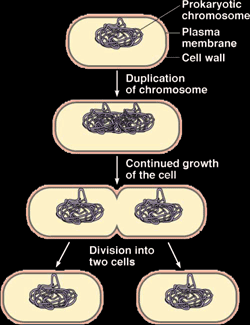 |
Asexual Reproduction in Potato Plants:
A potato plant starts as a lateral bud (seed) under the soil. In favorable conditions, a shoot grows out from the bud vertically, which then becomes the stem of the plant above the soil. Roots also grow out of the bud downwards into the soil. The bud is now a plant. The stem then grows a part of it under the soil, which is called underground stem. Swellings start to grow from the underground stem; these swellings are called tubers which are the new potatoes. Glucose formed by photosynthesis in the leaves of the above ground stem is converted into sucrose and transported down the stem to the tubers to be stored there as starch. When the tubers are fully grown the mother plant dies and the new lateral buds form on the tubers. These buds then grow into new potato plants identical to the mother plant.
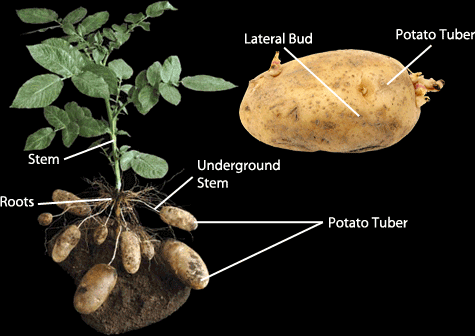
Sexual Reproduction:
Sexual reproduction is the process involving the fusion of haploid nuclei to form a diploid zygote and the production of genetically dissimilar offspring.
Sexual Reproduction in Flowering Plants:
In a plant, the organs which are responsible for sexual reproduction are the flowers. The diagram below shows a typical flower.
Sex cells are called gametes. The male gametes are produced inside the anther. And the female gametes are produced inside the ovules. Some flowers can produce both male and female gametes. They are called hermaphrodite. Male gametes are inside pollen grains in the anthers.
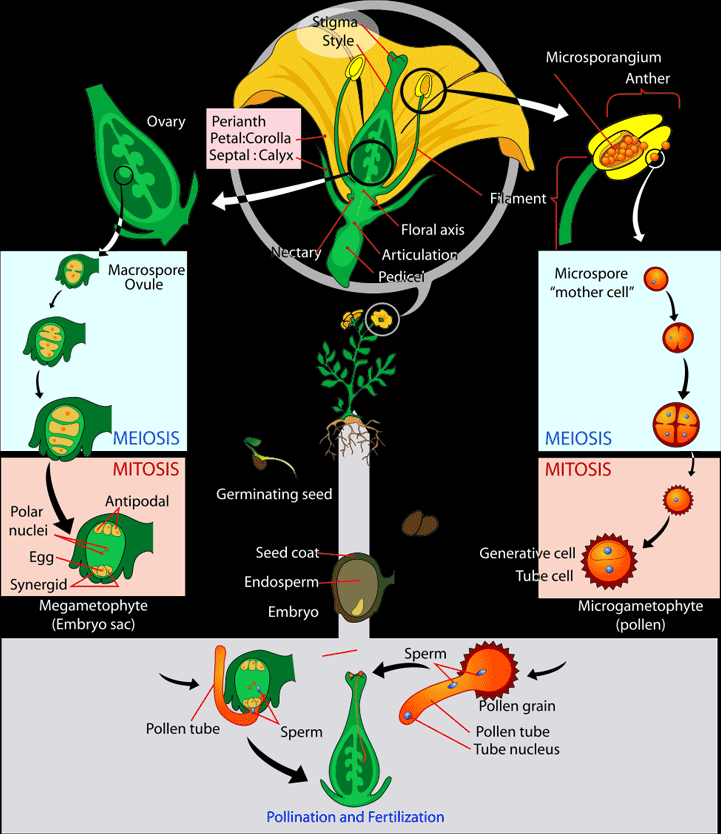
Methods of Pollination:
Pollination is the transfer of pollen grains from the male part of a flower to the female part of a flower. There are two methods of pollination, insect pollination and wind pollination. Some flowers pollinate by insects while others pollinate by wind.
Insect pollinating flowers have special attractive features like brightly colored petals, attractive scents and sugary nectar. These features’ aim is to attract insects like bees to come and collect their nectar. While an insect is collecting the nectar, its body will touch the anthers. The pollen grains of insect pollinating flowers have hooks and spikes all over them in order to stick to the bodies of the insect that touch it. When this happens, the pollen grain sticks to the body of the insect. When the insect moves on to another flower to collect its nectar, the pollen grain falls
Off the insect onto the stigma of the flower, thus insect pollination took place.
Wind pollinating flowers however look very differently to insect pollinating ones. This is because they do not need attractive features such as bright colors and scents and nectar to attract insects. Instead, their petals are green or brown with their anthers and stigmas hanging outside the flower to be exposed to the wind. When wind is strong enough, it will blow the pollen grains off the anther and carry it along. At some point the wind will get weaker and the pollen grain will land, if it lands on the stigma of a flower of the same species then the pollination was successful. The surface of pollen grains of wind pollinated plants is smooth because it does not need spikes to catch on insects.
Self Pollination and Cross Pollination:
Self and cross pollinations are the two types of pollination.
Self pollination: The transfer of a pollen grain from the anther to the stigma of the same flower or the stigma of a flower of the same plant.
Cross Pollination: The transfer of a pollen grain from the anther to the stigma of a flower of another plant of the same species.
Self pollination is considered sexual reproduction because it involves the fusion of two gametes together even though they might come from the same flower or plant.
Fertilization:
If a pollen grain lands on the stigma of a flower of the same species, fertilization takes place. This starts by the stigma secreting chemicals that start what’s called a pollen tube. A pollen tube is the pathway in which the pollen moves downwards to reach the ovule. If a pollen grain falls on the stigma of a flower of a different species, the stigma will not secrete these chemicals and fertilization fails. At the tip of the pollen tube, enzymes are secreted that digest the tissue of the style digging the pollen tube further down till it opens on the other end in the ovule. The male gamete enters the pollen tube and starts its journey downwards to the ovule.
When the male gamete reaches the ovary, it enters the ovule through a whole in its outer shell. The male gamete, which is a haploid nucleus starts fusing with the ovule producing a diploid zygote, then develops into an embryo plant.
Seeds and Fruits:
During the early stages of fertilization, some parts of the fruit become useless, they die and fall off. These parts include the sepals, the petals and the stamens.
The fertilized ovule becomes a seed. Inside the seed is the zygote which develops into an embryo plant. An embryo plant has shoot called plumule and a root called radicle. The plant makes food for the seed and brings it to the seed where it is stored in a structure called cotyledon inside the seed. The outside layer of the ovule becomes thicker and harder and is now called the testa. In the seed there is a hole called the micropyle, this is the whole through which the male gamete entered the ovule. When the seed is fully grown, it becomes dormant. That means it loses its water and metabolic reactions inside it stop. These reactions are reactivated when the seed is planted in favorable conditions including water and air; this is when the seed grows into a new plant. This enables the seed to survive hostile conditions until it is put in somewhere where it can grow into a plant.
The ovary of a flower contains many ovules. The ones that are fertilized turn into seeds and the ovary its self turns into a fruit in which the seeds are. The function of the fruit is to protect the seeds and to disperse them from the parent plant to colonize new area.
Seed Dispersal:
Seed dispersal is the scattering of the seeds all over the place to colonize he area. It always the plants to grow in new places and contribute to variation of species. A plant can use any of two methods of seed dispersal. These methods are wind dispersal and animal dispersal. Wind dispersal depends on the fruit having wind or parachute like structure that allows it to float in air to be carried by wind to distant areas in order to spread the species. The photo on the left is of a dandelion plant. Its fruit grows feathery threads that make it fly over long distances before landing on the soil. |
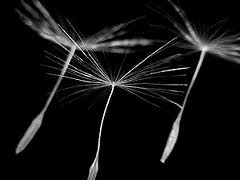 |
The photo on the left is of a sycamore plant. Its fruit grows two wings like structures that make it spin and fly to distant areas before landing in the soil thus spreading the species.
Other plants rely on animal dispersal. In this method the fruit has hooks all over it which catch in the fur of animals. The animals move from place to place taking the fruit with it until at some point it falls somewhere away from the parent tree. An example of this type of plants is the burdock plant.
Seed Germination:
A seed remains dormant until it is put in suitable conditions to start growing. These are:
- Water
- Air (oxygen)
- Suitable temperature
- Some need Sunlight
If the seed is put in an area of these conditions it will start germinating. Germinating includes the following steps:
- The water activates enzymes stored in the seed,
- Enzymes start to digest the starch stored in the seed into sugars,
- The sugars produced taken to the embryo and is used as an energy source for growth,
- The radicle (root) grows first, fixing the seedling into the soil where it can absorb more water,
- The seed is now called a seedling,
- Then the shoot grows vertically,
- Once the shoot grows the first green leaf the seedling becomes fully independent (before that it was depending on its storage materials),
- The plant is now able to photosynthesis and make its own food.
Sexual Reproduction in Humans:
In humans, the female sex cell (gamete) is called an egg or ova (Plural: Ovum). The male sex cell in humans is called a sperm. Sexual reproduction in humans starts by a sexual intercourse followed by the fusion of the two gametes together forming a zygote (Fertilization).
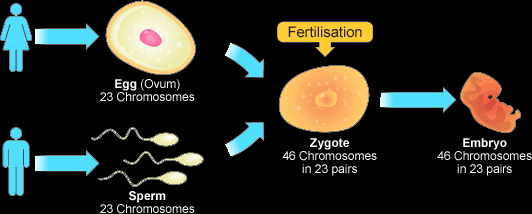
The Female Reproductive System:
The female reproductive system is located under the stomach. It consists of the following parts:
- The Ovaries: There are two ovaries. One on each side. They contain follicles where eggs are produced,
- Oviducts (Fallopian Tube): They are two tubes, one on each side connected to an ovary. They are where fertilization occurs and they provide a pathway for the eggs to travel to the uterus by sweeping them by cilia on its walls,
- Uterus (Womb) : Where the fetus develops,
- Cervix: A muscular tissue which separates the vagina from the uterus,
- Vagina: it receives the male penis during sexual intercourse.
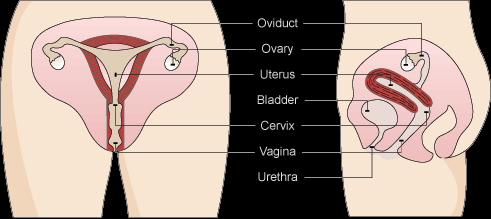
The Male Reproductive System:
The male reproductive system is also located under the stomach. It consists of the following parts:
- Testes: a male human has two testicles. A testes is a male gland which produces sperms and the male sex hormone testosterone,
- Scrotum: it is the sac which contains the testicles,
- Sperm Ducts (Vas deferens): They are two muscular tubes, each connected to a testis. They carry the sperms from the testis to the urethra,
- Prostate Gland: It secretes a nutritive fluid to the sperms to form a mixture called semen,
- Urethra: It is a tube inside the penis which is the pathway of semen and urine out of the body,
- Penis: It is the male sex organ which ejaculates semen into the vagina during sexual intercourse,
- Epididymis: coiled tubes in which sperms are stored,
- Seminal vesicle: it is another gland like the prostate gland. It also secretes nutritive fluids for sperms to feed from and swim in forming semen.
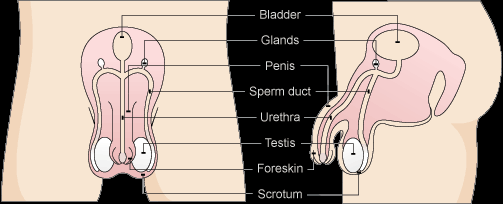
The testicles are inside the scrotum which hangs outside the body. This is because testicles work best at a temperature below that of the body.
Comparing Male and Female Gametes:
Eggs are much bigger than sperms. This is because it needs space to store nutrients on which the embryo feeds on before it reaches the uterus. Eggs being very large make it wasteful to make plenty of them; this is why a woman has one egg at a time. Sperms however are much smaller and in larger quantities to increase the chance of successful fertilization. Sperms feed on nutrients in the semen fluid. Eggs are unable to move by them selves, they are swept to the uterus by cilia in the walls of the oviduct. On the other hand, sperms have long tails which helps them swim their way to the egg. A sperm also has a large number of mitochondria to release lots of energy to be used in swimming.
The Sexual Intercourse:
The penis of a male is full of erect tissue and blood vessels. During sexual intercourse the blood pressure increases in the penis making it stiff and erect first to be inserted into the woman’s vagina.
Stimulation at the end of the penis causes the muscle tissues along the sperm duct to contract in a wavy-like motion squeezing the sperms from the epididymis to into the sperm duct. The sperms are squeezed past the prostate gland and seminal vesicle which secrete the nutritive fluid to the sperms forming semen.
Sperms + Nutritive Fluid = Semen
The muscles keep contracting against the sperm duct squeezing the semen out of the body through the urethra in the penis. The ejection of semen out of the body is called ejaculation. During one ejaculation, about 500 million sperms are secreted.
The semen is ejaculated in the vagina just below the cervix. The sperms are now ready to begin their long, dangerous journey to the egg. The sperms use sugars in the nutritive fluid to release energy which is used to swim through the cervix and in the film of water lining the uterus until they reach the egg. They swim using their tails.* In the woman, an egg lives for several days in one of the oviducts. When the egg dies it is released in the uterus. Fertilization will be successful only if the egg is still living in one of the oviducts. The egg produces chemicals which attract the sperms to it. Many sperms may arrive to the egg but only one can fertilize it. |
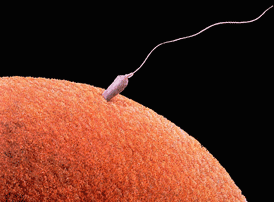 |
The sperms gather around the egg and compete for it by secreting enzymes which can digest the wall of the egg. Once one of them succeeds in penetrating the wall of the egg, it gets in leaving its tail out. At the same moment this happens, the egg produces an impermeable wall around it called fertilization membrane which prevents any more sperms entering the egg. No the nucleus of the sperm can fuse with the nucleus of egg, this is fertilization.
Implantation and Development:
After the nuclei of the sperm and the egg fuse together, they become a single cell called the zygote. Next, the zygote keeps dividing and producing more cells until a tiny ball of cells is formed. This ball is no bigger than the original egg and is called the embryo.
Fertilization occurs in the oviduct. The development into an embryo takes place while it is moving slowly down the oviduct to the uterus, where the embryo starts developing further. When the embryo reaches the uterus it sinks into the soft lining of the uterus and becomes attached to it. This is called implantation.
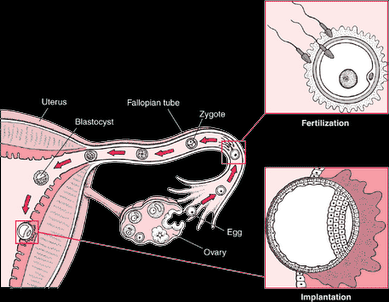
Pregnancy:
After implantation, the embryo starts further development. Some of the cells of the embryo grow into projections or villi which are fixed firmly into the wall of the uterus. The uterus of the mother also grows set of projections or villi, the two sets of projections grow closely together to form a structure called the placenta which will be used in substance transfer between the baby and the mother.
The embryo also starts forming a bag around the baby; this bag is called the amnion. The majority of the cells of the embryo start dividing rapidly producing a fetus, which is the baby.
Sperm/Egg → Zygote → Embryo → Fetus
The placenta has two sets of villi, the fetus’s set which contains the fetus’s blood capillaries, and the mother’s set which contains the mother’s blood capillaries. The blood flows from the fetus to the fetus’s blood vessels in the placenta through umbilical arteries and veins.
The function of the placenta and the umbilical cord is to exchange substances between the mother and fetus without mixing their bloods together. This is because they might have different blood groups or the mom might have a disease that could be passed to the fetus. The blood circulation of the fetus includes the placenta. When the blood reaches the blood capillaries of the fetus in the placenta, waste substances like carbon dioxide and urea diffuse from it to the maternal (mother’s) blood. The mother then gets rid of these waste materials. Useful substances also diffuse from the maternal blood to the fetus’s blood. These include oxygen, amino acids, glucose, vitamins, water, minerals, fatty acids & glycerol. These nutrients are used in building the body of the fetus. Some useful substances also diffuse from the maternal blood to the fetal (fetus’s) blood like antibodies and antibiotics. |
 |
The placenta has another very important function. That is making oestrogen and progesterone hormones which are essential to keep the uterus in good condition and stimulate milk-producing tissues in the mother.
The fetus which is inside the amnion is surrounded by a fluid called amniotic fluid. This fluid protects the fetus from mechanical shock so that it doesn’t get harmed if something hits the mother’s stomach. The fetus needs no space to breath because it doesn’t, get its oxygen from the mother and gets rid of the carbon dioxide through her too.
The Mother’s Diet:
A pregnant woman’s diet is different to that of a normal woman. This is because a pregnant woman needs extra supplies of most nutrients because she is feeding both her self and her baby.
Proteins should be increased in a pregnant woman’s body. The growing fetus needs plenty of protein to build new cells. Carbohydrates should also increase since the fetus consumes them too and because it is harder to move when the woman is pregnant. Calcium is one of the most essential minerals for the fetus’s growth. This is because it is used in making the bones. If the mother does not increase her intake of calcium the fetus will start absorbing it from her bones and teeth. Iron is needed in large quantities as well. This is to produce more hemoglobin for the mother and the fetus. Drugs should be avoided. The effects a drug has on the mother are also had on the fetus but on a larger, more fatal scale. Drugs can cause unhealthy babies or even early birth giving of an abnormal baby.
Giving Birth:
Nine months after fertilization, the fetus becomes ready to be given birth. Birth starts by the muscles of uterus starting to contract. This causes some pain for the mother. When it is time for the baby to go out, the frequency of the muscle contractions of the uterus increase and they contract more this causes the amnion to break letting the amniotic fluid out. The mother could help in this stage by shouting out loud since it makes the muscles of her body contract. The muscles of the uterus keep contracting pushing the baby out. First out is the head of the baby followed by the rest of the body slipping out. The umbilical cord which still links the baby with the mother is now ready to be cut and tied safely.
Feeding the Young Baby:
The best food for a new born is breast milk. This is because breast milk contains all essential nutrients for the baby like proteins, fats, sugars, vitamins and minerals in easily digestible form. The mother’s milk also contains antibodies which are needed by the baby since their immune system has not developed yet. Moreover, breast feeding builds a close bond between the mother and her baby.
If the mother cannot breast feed for any reason, there is another alternative which is formula milk powder. Formula milk powder is mixed with boiled water and fed to the babies in bottles. Formula milk however contains nutrients in harder digestible form which is a disadvantage. Formula milk also lacks of antibodies which are needed by the baby which makes a bottle feeding baby in a greater risk of infection than a breast feeding baby.
Increasing Fertility:
Some couples are unable to have babies. This could be due to lack of egg production in the woman. If this is the case, the problem could be solved by prescribing the woman hormones called fertility drugs which contain a hormone called FSH. Those drugs make her ovulate to make her produce healthy eggs which can be fertilized.
In other cases, the problem could be caused by a problem with the woman’s ovaries or the man’s sperm’s activity. The solution in these cases is called Vitro fertilization. In vitro fertilization, the woman is first given fertility drugs to make her produce a lot of eggs. These eggs are then taken out of the woman and replaced in a sterile dish. Then, the man’s sperms are added to the dish. After fertilization happens, one of the fertilized eggs is taken from the dish in put back in the woman’s uterus. If this is correctly done, the zygote will develop and the woman will get pregnant.
If there is no hope in the man’s sperm, a sperm donor is needed. This is another man who donates his sperm to fertilize the woman’s eggs. This can be done naturally by sexual inter course or by vitro fertilization. This method is called artificial insemination.
Methods of increasing fertility cause a fuss around the world. Some people say that the world’s population is big enough and that couples who are unable to have children should deal with it. Others however, think its every couple’s right to have kids. Some people also claim that increasing fertility costs great expenses and that money could be used wisely in other needs.
The Menstrual Cycle:
In a normal woman, one egg is released from the ovaries per month. This is accompanied by other changes. For example, the inner lining of the uterus becomes ready to receive a fertilized egg. The lining of the uterus becomes full of blood capillaries and soft. If fertilization doesn’t take place at that time, the egg dies, this is also accompanied by other changes. The thick lining of the uterus becomes unneeded and it breaks down and gets out of the body through the vagina with the dead egg over a period of 4-7 days. This is called menstruation. These events are part of what’s called the menstrual cycle which takes place monthly in a 12-50 years old woman’s body. The diagram on the right represents events of the menstrual cycle. The menstruation cycle is controlled by 4 hormones. Two of these are made by the ovaries and they are called oestrogen and progesterone. The other two are made by the pituitary gland and they are called the FSH and LH hormones. During menstruation at the beginning of the cycle, the pituitary gland secretes FSH and LH hormones. These hormones stimulate the ovaries to secrete oestrogen hormone, the function of this hormone is to rebuild the lining of the uterus again once menstruation is finished. |
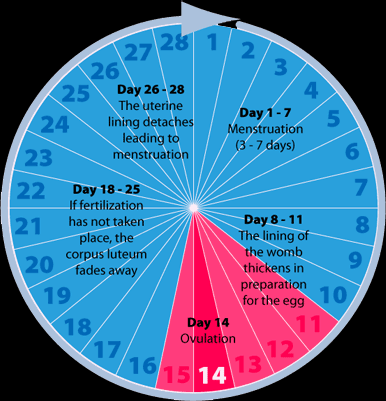 |
Next, the pituitary gland increases the amount of FSH and LH hormones secreted, specially the LH. The large amounts of LH hormone cause the ovary to release an egg, this is ovulation. This is when fertilization is most likely to be successful if sexual intercourse took place.
Then the amounts of LH, FSH and oestrogen hormones secreted drop. The place where the egg was in the ovary gets occupied by yellow cells which produce and release progesterone hormone. Progesterone maintains the good condition of the lining of the uterus to ensure implantation if fertilization took place.
If the egg is not fertilized, the yellow cells in the ovary disappear and the progesterone is no longer produced. This causes damage to the lining of the uterus which soon breaks down. Thus menstruation takes place and the cycle starts all over again.
Birth Control:
Birth control is controlling the number of children and the time to have them. A couple may use birth control if they are not ready to have a baby yet. There are several types and methods of birth control. Types of birth control are natural, chemical, mechanical and surgical.
There are two methods of natural birth control. These are abstinence and rhythm method. Abstinence method is simple avoiding sexual inter course, this way there is no chance the woman will get pregnant.
Rhythm method is based on the woman understanding her menstrual cycle (period). The woman must be able to sense and predict the time of ovulation when the egg is in the oviduct waiting to be fertilized, and not have sexual intercourse at that time. The woman can know when it is ovulation time of the cycle by sensing it signs which are change in the natural secretions in her vagina and a slight rise in body temperature. For some women however, it is very difficult to tell when it is ovulation time to avoid having sexual intercourse at it. This can be due irregular periods or unclear signs of ovulation. This is why the rhythm method is not very reliable.
The chemical type depends on the couple taking chemicals that prevent fertilization or even ovulation. The most chemical method of birth control is the contraceptive pill. This is a pill which contains chemicals that prevent the ovaries releasing an egg to the oviduct (ovulation); there won’t be an egg ready for fertilization. In some cases, the pill has to be taken every single day, if it is forgotten once there is a chance of pregnancy. The pill is very effective, but it is not preferred by some women since it could bring other side effects such as mood swings, weight gain or circulatory diseases like strokes. The pill has to be prescribed by a doctor who performs a check up on the woman in advance.
The alternative chemical method of birth control is the spermicidal cream. This is a cream that contains a substance that will kill sperms. The cream has to be placed in the woman’s vagina before sexual intercourse so that it kills the sperms that will be ejaculated. The cream is not entirely effective on its own since some sperms may survive, but it could be used along with other birth control methods.
There are four mechanical methods of birth control namely; condom, femidom, diaphragm, and IUD. The condom is the most used method of birth control. It is simply a layer of cover worn on the penis to keep semen from entering the woman’s body. It is made of stretchy, impermeable material that won’t allow any substance entering the woman’s body from the man or vise versa. The condom also has a great advantage; it also prevents diseases or bacteria and viruses passing from the man to the woman or vise versa. The condom is one of the most reliable methods of birth control.
Femidom is a female condom that is worn by the woman instead of the man. It acts like a bag in the vagina in which the penis is inserted and the semen is ejaculated without entering the woman’s body.
The third mechanical method of birth control is the diaphragm. The diaphragm is a small, circular piece of rubber which is fit over the woman’s cervix to prevent sperms from passing through it. It is impermeable and it can be used along with spermicidal cream to ensure that sperms will not pass through the cervix.
The last mechanical method for birth control is the intra-uterine device or IUD for short. This is a coil of copper or plastic that is fit in the woman’s uterus to block the passage of sperms. It is not recommended though because it has some unpleasant side effects like making the periods heavier.
As for surgical methods, one of the couple can perform a surgery to prevent their gametes reaching the site of fertilization. For example the woman could have an operation to cut and seal her oviducts to ensure that the egg can’t pass down to the uterus. Or the man could have his sperm ducts cut and sealed, in this way the sperms won’t even leave his body. This surgery is called vasectomy and the man is considered sterile after it. These methods are irreversible and the person who does it can never have kids again.
Sexually Transmitted Diseases:
Sexually transmitted diseases or STD’s for short are caused by viruses or bacterium passing from one partner or another during sexual intercourse. The most spread STD’s are gonorrhoea and HIV (also known as AIDS).
Gonorrhoea is caused by a bacterium that lives and breeds in damp conditions at 37oC. It lives in the reproductive system of the carrier person. The bacteria could be easily transferred to the partner during sexual intercourse. Symptoms of gonorrhea in men are very clear. They include spores on the penis, discharges and painful urination. In women however, the symptoms are less noticeable because women’s reproductive organs are inside her body. They include discharges which the woman won’t be able to differentiate between and the normal vaginal discharges. If a pregnant woman catches the disease, it is likely that the baby will catch it two during giving birth. The disease is easily cured by a course of antibiotics and could be prevented by means of birth control and not having sexual intercourse with more than one person.
AIDS is a disease caused by the HIV (human immunodeficiency virus). The virus lives in most of body fluids such as blood and reproductive tract. It could be easily transmitted to the other partner during sexual intercourse because their reproductive tracts come in contact. The virus lives in breeds in lymphocytes (white blood cells). The virus could live for years in the body before it starts showing symptoms of the disease. AIDS is short for Acquired Immune Deficiency Syndrome. The disease prevents white blood cells from killing bacteria and viruses, so one or more weak viral or bacterial infections are enough to kill the patient. There is no cure for AIDS till now, it is best to prevent it from spreading by not having sexual intercourse with an infected person. AIDS could also be spread by blood, so it is best prevent your blood mixing the blood of an infected person or share unsterilized, needles that have been used by an infected person to inject drugs into your self.